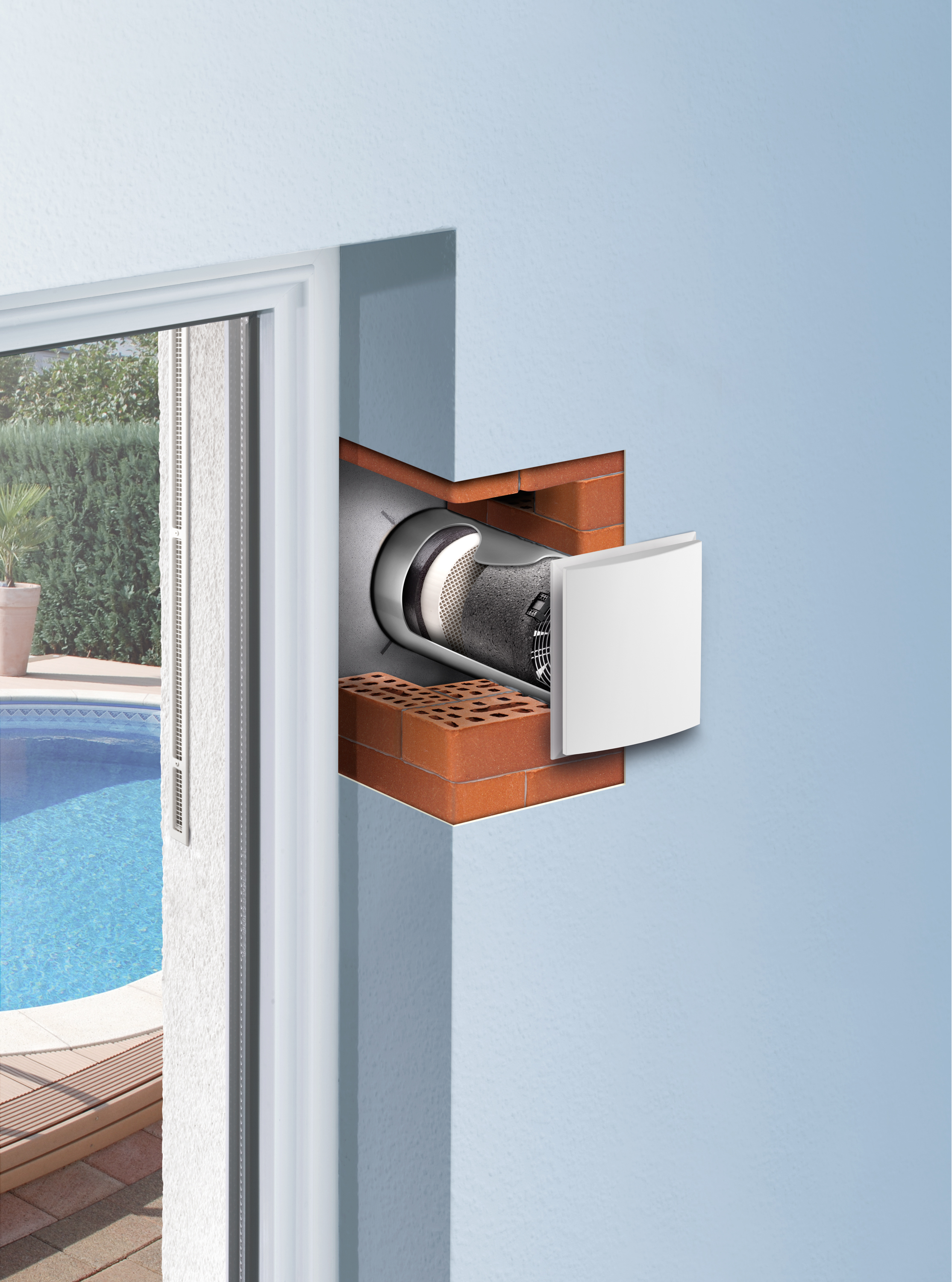Good “fit” in small-space renovations
By Christy Crocker

The Lunos E2 is one of several through- wall energy recovery ventilation models that provide a low-profile solution for small spaces where ductwork is not feasible. Photo courtesy of Lunos.
THROUGH-WALL ENERGY recovery ventilation (ERV) units are relative newcomers to the residential ventilation and high-performance building arena, offering a practical ventilation solution when full-size units aren’t an option. The units are designed to blow in for 70 seconds and then reverse and exhaust out for 70 seconds. They are typically installed in pairs, working in tandem to blow and pull air across a space for maximum ventilation. Most units have a ceramic energy-recovery core that absorbs heat energy and some moisture from the outgoing air and transfers both back into the incoming air, making them an asset to energy efficiency. Some units, depending on their installation, can be programmed to have a variety of settings, including Off, Low Air Exchange, High Air Exchange and Exhaust.
Through-wall ERVs can be very useful for adding ventilation to indoor spaces, but they are not without limitations in their application or their cost.
Good quality units cost $1000-$1200 per pair uninstalled, with approximately 3 hours of time needed per unit to install. In theory, multiple pairs of units could be installed throughout a home to provide whole-house ventilation; however, there are some drawbacks with this strategy. At $1500 per pair, installed, it doesn’t take long to exceed the cost of a fully ducted and balanced ventilation system, which averages $5000 for the typical Maine home (or $7500 for higher efficiency units). In high-performance construction, the goal is an extremely air-tight building enclosure. For each through-wall ERV installed, you have a penetration from the inside to the outside, creating drafts particularly when the units are in “off ” mode. More devices mean more pieces of mechanical equipment to monitor and maintain, and you have less control over the actual delivery of ventilation compared to ducted, balanced systems.
So while through-wall ERVs may not be the best solution for whole-house ventilation, they certainly do have value in the ventilation arena. The best bang for your buck with through-wall ERVs occurs in smaller indoor spaces where installation of a full-size ERV and ductwork isn’t feasible or desirable. Because they are mounted within the wall system and don’t require extra space for ductwork, through-wall units are a great solution for small space retrofits, as well as for tiny-house owners, for whom every square inch of space has value. And, because of their ability to pre-warm incoming fresh air, through-wall systems provide a more comfortable ventilation option than other strategies, such as fans in windows. Other useful considerations include:
- Providing ventilation to the most important rooms in a home (where people spend the most time), such as bedrooms, living rooms, and home office spaces
- Ventilating spaces that have the greatest potential to pollute the house, such as hobby spaces or basement workshops
- Apartments, townhouses, and hotel spaces where the costs and space needs for ducted systems are prohibitive
- Temporary installations in window frames where ventilation is desirable, such as college dorm rooms. Just
unplug and take with you when the semester is over!
Nothing is so telling as a good, solid testimonial, so here are two: Alan Plummer, the Maine chapter representative of the American Tiny House Association and owner and occupant of a 180 square-foot tiny house, has this to say about his Lunos E2s that he installed several years ago:
I love them! Although fairly expensive, I wouldn’t recommend that any tiny house owner actually live in their tiny house unless they have something like this. Tiny houses can trap a lot of moisture, and I know other tiny house owners who have had significant mold and moisture problems because they didn’t ventilate. I have my units in opposite corners of my house, and even with myself, my dog, my cooking, and my showering, I have never had any condensation problems, ever. I can hardly hear them, and they continue to work well even in extremely cold temperatures. I rarely turn my units off.
Jesse Thompson, an architect with Kaplan and Thompson Architects in Portland, Maine, has also had positive experiences with using through-wall ERVs in spaces where installing ductwork is difficult:
We’ve done a couple of multi-unit projects where we installed through-wall units in every hotel room and every bedroom. These ventilators are a great fit because they don’t need ductwork. And they’re quiet. We were able to adjust them to work well in varying spaces and existing mechanical systems. We had a few challenges in some classic 1980s townhouses that only had 2” x 4” walls, so the through-wall ventilators were too thick for the wall depth. We built little trim boxes to account for the extra width, and have since had no trouble. These are a great solution for apartments, townhouses, hotels, and other spaces where ductwork just isn’t an option.
Christy Crocker is the executive director of the Maine Indoor Air Quality Council. For more information, visit www.maineindoorair.org.

This article was re-printed from the spring/summer issue of Green & Healthy Maine HOMES. Subscribe today!







